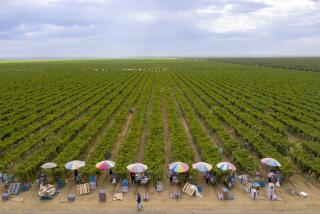Most of Town’s Migrant Worker Housing Is Substandard, but Proposed Campground Solution Is Seen by Some as . . . : Not Much Better Than Nothing : Judge to Rule on Building of Rudimentary Shelters
MECCA, Calif. — Beyond the glitz of Palm Springs and the retirement bliss of Rancho Mirage, the California desert unfolds into a less dreamy reality: the vast agricultural tracts of the Eastern Coachella Valley, one of the state’s most productive farm regions.
Acres of gnarled green vines that carpet the land attest to the area’s status as the home of California’s earliest annual table-grape harvest, which is again drawing the customary thousands of migrant laborers, mostly men from Mexico.
As they do every year, the workers cram into a mix of mostly substandard, overcrowded housing--from overpriced apartments, trailers, barns, sheds and garages to ramshackle shantytowns amid the brush. Many sleep in cars and trucks; others bed down beneath the broad desert sky, some in the central plaza of this farm hamlet.
“At least there’s no snakes here,” Jesus Reyes Banuelos, a 52-year-old father of six from Mexico, said recently as he showed a visitor the tattered cardboard mat in Mecca’s town square where he planned to sleep that evening.
Last month, Cesar Chavez, president of the United Farm Workers of America, pointedly chose Mecca to kick off a higher-wage campaign, citing what he called the workers’ abysmal accommodations in this town 140 miles southeast of Los Angeles.
“The housing conditions here in the Coachella Valley are some of the worst I’ve seen anywhere,” Chavez said after a spirited rally that drew several hundred people, most of them field laborers.
Under pressure to improve housing of farm workers, the Riverside County Housing Authority has opted for a novel and controversial approach: building the Mecca Migrant Farmworker Campground.
Plans for the complex of 53 “shade” shelters--consisting of concrete slabs with metal roofs, communal bathrooms and barbecue pits--have been on the drawing board since 1985. However, funding shortfalls and other problems delayed land clearing until this spring.
But with the site now graded and slabs ready to be poured, a Superior Court judge has temporarily halted the project so that critics could make their case that it violates laws ensuring safe and adequate housing. Attorneys say it is the first time in California, and maybe in the nation, that a governmental entity has attempted to construct such housing for farm workers.
Proponents call the campground visionary, largely because of its low cost compared to more permanent dwellings.
“This would be exactly like camping out in our state parks, only it would be for people working in the area,” said the project’s champion, Patricia A. (Corky) Larson, a Riverside County supervisor and longtime grape-grower from Palm Springs.
But detractors reject the idea as a chilling and degrading blueprint that could legitimize second-rate housing for agricultural workers, with possible repercussions statewide.
“This is pathetic. It would send us back to the 1700s in terms of farm-worker housing,” said Jose Arturo Rodriguez, an attorney for California Rural Legal Assistance, the nonprofit agency that sued to block construction of the campground.
Riverside County officials have rejected more standard approaches--such as attempting to secure federal migrant housing funds--and have instead decided to commit almost $1 million to the campground.
A Superior Court judge in Indio is scheduled to rule this month on whether construction should proceed.
The shelters would have no walls to shield inhabitants from wind, dust, rain or the extreme temperatures of the desert, which can soar past 120 degrees in the summer or drop below freezing in winter. Although women are part of the work force and many migrants travel with children, there is no privacy.
Bedding is not part of the plan. Bathrooms and showers will be provided at centralized sites. Cooking facilities will be limited to outdoor barbecue pits and gas stoves. Overnighters would pay rates from $5 to $11 per day.
To Rodriguez and other advocates for migrants, the campground represents a potentially harrowing precedent in a state where many counties, and cities from San Diego to Napa, are examining new ways to construct affordable housing for farm workers.
“I’m afraid that a lot of other housing authorities and local governments would also like to take the easy way out,” said John Mealey, executive director of the Coachella Valley Housing Coalition, an Indio-based nonprofit group that has won praise for sponsoring the construction of more than 400 apartments in the region for field hands and other low-income residents.
The grape harvest here, lasting from late May to early July, attracts as many as 10,000 migrant workers, many of whom stay a month or more. Most eventually move on to vineyards in the San Joaquin Valley and elsewhere, but others stay to work in the region’s vast, labor-intensive farm economy, which also produces vegetables, citrus fruits and dates.
Workers seemed unaware of the campground plan, but few appeared enthusiastic. “There won’t be any walls?” asked Leonel Favela, 28, one of about 100 laborers and their families residing in a crude encampment of plywood shacks and battered trailers.
“How can we live without walls?” asked Favela, whose dirt-floor, hand-built shanty, shared with at least three other men, does feature a roof and walls.
“There’s too much heat and too much dust blowing around to live here without walls,” said Juan Manuel Sanchez, 32, another resident of the settlement, where sewage runs freely in a central path and residents get drinking water from a farm tap. “I don’t think I’d go there.”
William A. Rosenberger, executive director of the Riverside County Housing Authority, acknowledged that officials had not surveyed farm workers for their views on the campground.
“Would I rather have (permanent) housing for everyone? In a utopia, yes,” said Rosenberger, who added that the county is seeking funding for a 40-unit migrant housing site near the campground but is otherwise short of money.
Critics charge that the county put too little effort into seeking funds from federal and state sources. “There’s money out there to build good, solid housing,” Mealey said. “I don’t think the county should be in the business of assisting people to live in substandard housing.”
Farm-worker housing advocates find themselves in an ironic position: They are fighting to prevent the only government-sponsored project for field hands currently planned here, where the need is among the most acute in all of California.
“Would we prefer nothing over this?” asks Rodriguez, the offspring of a farm-working family of Northern California. “Unfortunately, the answer is, ‘Yes.’ ”
“It’s typical fuzzy-headed, liberal thinking,” countered Supervisor Larson, who held an interest in her family’s grape-growing business, Desert Fruit Ranch, until late 1989. “They’d rather see people stay in unsanitary conditions.”
As part of its lawsuit, California Rural Legal Aid raised health concerns, voicing fears that children living in the campground might be vulnerable to disease.
“I believe this campground is demeaning to the migrant farm-working families and virtually inhumane,” Dr. George C. Gonzalez, a Fresno doctor who has worked with field hands, said in court papers.
Not so, says Douglas Phillips, a Rancho Mirage attorney representing Riverside officials. “It’s certainly a major improvement compared to current living conditions,” he said. “The board felt this is the best they could do for those folks.”
More to Read
Sign up for Essential California
The most important California stories and recommendations in your inbox every morning.
You may occasionally receive promotional content from the Los Angeles Times.










